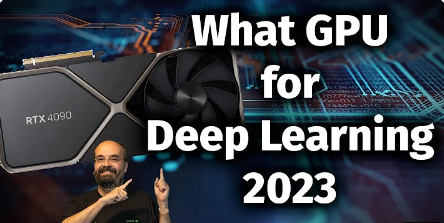If you’ve ever trained a machine learning algorithm, you know how long the process can take. Training models is a hardware-intensive task, and GPUs help a lot in cutting down training time. But you may have heard online that a GPU isn’t mandatory for doing ML, you can just do fine without one. Or can you?
Suggested: 9 Best Laptops for Machine Learning in 2023.
What is machine learning?
Machine learning is a form of artificial intelligence that teaches computers to act in a similar way to how humans do: Learning and improving upon past experiences by the use of data. ML algorithms build a model based on sample data, known as training data, in order to make predictions or decisions without being explicitly programmed to do so.
Nowadays, machine learning is used in a wide variety of applications, where it is difficult or unfeasible to develop conventional algorithms to perform the needed tasks.
Machine learning is hardware-intensive
Machine learning is in essence a mathematical and probabilistic model that requires tons of computations. The model is created in four steps:
- Preprocess input data.
- Train the deep learning model.
- Store the trained deep learning model.
- Deploy the model.
Among these steps, training the model is the most computationally intensive task. The bigger your dataset, the more time it will take to train.
A high performance GPU is crucial
By 2019, graphic processing units (GPUs), especially the ones with AI-specific enhancements, had displaced CPUs as the dominant method of training large-scale commercial cloud AI.
Because at its core, machine learning is all about crunching numbers and solving matrices. Training an ML algorithm involves a lot of matrix operations, especially if you have a large dataset. That’s where parallelizing computations can change things.
Compared to CPUs, GPUs are way better at handling machine learning tasks, thanks to their several thousand cores. Using a CPU to perform ML tasks is fine for studying. But as your datasets become larger, you’ll need a good-quality GPU or wait days to finish training.
CPU vs GPU
CPUs are faster than GPUs, but they compute sequentially and only feature a few processor cores – which offer rapid and focused sequential processing. A GPU is specially designed to crunch numbers – because graphics processing is mostly complex matrix operations.
So although GPUs are much slower in terms of clock speed they feature a huge number of processing cores with built-in AI enhancements. The high number of cores allows GPUs to parallelize matrix operations, and cut down processing time.
To give an analogy, say you have to deliver pizzas and you have 8 fast bikes. Each motorcycle can deliver one order at a time. But if you have more than 8 orders, say 400, then it’ll take a long time to deliver all of them- even though you have fast bikes. This is how CPUs work: They are fast and sequential processors that perform operations one after another.
On the contrary, a GPU is like having 500 motorbikes with average speed. Even though they aren’t as fast, you’ll be able to deliver all of them at once. The ability to parallelly deliver more pizzas makes up for the slower speed.
To conclude, CPUs easily beat GPUs in terms of speed. However, GPUs have way more cores, which offsets the faster speed of CPUs. These thousands of cores allow a GPU to process many operations simultaneously and offer better performance in matrix operations. And that’s why they are better suited for things like virtual currency mining, deep learning, or machine learning.
Nvidia vs. AMD GPU for Machine Learning?
For ML or any other AI-related applications, Nvidia GPUs are perfect. Over the years, Nvidia has been putting hardware-level optimizations to better support AI-related tasks. Besides, their CUDA software development kit (SDK) supports all major machine learning frameworks. Combined with a large, helpful community and libraries, Nvidia is the perfect suit for most ML enthusiasts.
An alternative to CUDA is the OpenCL SDK, which works with AMD GPUs. But it doesn’t support the major ML frameworks out of the box. Although AMD is pushing for better support and hardware acceleration, it may take a few years before we recommend an AMD GPU for ML.
For now, if you want to practice machine learning without any major problems, Nvidia GPUs are the way to go.
Important, not mandatory
A GPU is a specialized processing unit with enhanced mathematical computation capability, which makes it ideal for machine learning. But that doesn’t mean you can’t learn machine learning without a GPU. A CPU can just do fine unless you’re an expert who trains models with humongous datasets(which would take eternity on CPUs).
But still, if you’re just getting into ML, getting a good GPU can make your learning experience smoother.



